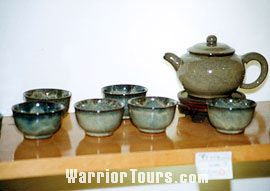Tea Wares & Selection

In China, people think different teas prefer different tea wares. Green tea prefers glass tea ware, scented tea porcelain ware while Oolong tea performs best in purple clay tea ware.
In its long history, tea wares can not only improve tea quality but also by-produce a tea art. Skilled artisans bestow them artistic beauty.
Tea wares consist of mainly teapots, cups, tea bowls and trays etc. Tea wares had been used for a long time in China. The unglazed earthenware, used in Yunnan and Sichuan provinces for baking tea today, reminds us the earliest utensils used in ancient China. Tea drinking became more popular in the Tang Dynasty (618 --- 907) when tea wares made of metals were served for noblesse and civilians commonly used porcelain ware and earthenware.
 In the Song Dynasty (960 --- 1279) tea bowls, like upturned bell, became common. They were glazed in black, dark-brown, gray, gray/white and white colors. Gray/white porcelain tea wares predominated in the Yuan Dynasty (1271 --- 1368) and white glazed tea wares became popular in the Ming Dynasty (1368 --- 1644).
In the Song Dynasty (960 --- 1279) tea bowls, like upturned bell, became common. They were glazed in black, dark-brown, gray, gray/white and white colors. Gray/white porcelain tea wares predominated in the Yuan Dynasty (1271 --- 1368) and white glazed tea wares became popular in the Ming Dynasty (1368 --- 1644).
Teapots made of porcelain and purple clay were very much in vogue during the middle of the Ming Dynasty. Gilded multicolored porcelain produced in Guangzhou,Guangdong Province and the bodiless lacquer wares of Fujian Province emerged in the Qing Qynasty (1644 --- 1911). Among various kinds of tea wares, porcelain wares made in Jingdezhen, Jiangxi Province and purple clay wares made in Yixing, Jiangsu Province occupied the top places.
Nowadays, tea wares made of gold, silver, copper, purple clay, porcelain, glass, lacquer and other materials are available.
To get a good cup of tea, quality tea leaves is a must. However, tea selecting needs knowledge. Generally, appraising tea is based on five principles, namely, shape of the leaf, color of the liquid, aroma, taste and appearance of the infused leaf. In addition, the dryness of the tea leaf will also affect the quality of the tea. One way it to hold the tea leaves. It is considered good if it pricks your hands and can be easily crumbled. Otherwise, the leaves are considered damp and hence, not good.

Speaking of the shape of the tea leaf, each kind of tea leaf has its specific external attributes. Hence, different tea has different appraising standards. In general, the shape, color, luster and size of the leaves of the good tea are usually even, with less tea stems, tea powders and broken tea.
With regard to the liquid color, different kinds of tea produce different colors when steeped in water. For example, green tea produces light green color, black tea produces turkey red, white tea is amber and Oolong produces golden color. Besides their standard liquid color, its appearance must be clear and bright with luster.
The tea aroma is one of the main criterions of quality tea. On account of the different processing methods and degrees of fermentation, different varieties have their distinctive aromas when dried. Green tea is fragrant, scented tea still gives out its light flower aroma, Oolong tea has the aroma of ripe fruit and black tea smells like caramel. Besides, the liquid of the good tea smells purely fragrant and strong to the taste.
Different tea tastes differently. Some tastes fragrant and mellow, some a little bitter and some with sweet aftertaste. Take green tea, for example, it tastes strong and mellow and gives a tea lover great pleasure after drinking it.
As for the appearance of the infused leaf, coarse and old leaves open easily after steeping in the water. This type of tea is not palatable. The quality and tender tea leaves will open gradually and tea made from it is strong. They can at the same time be infused time after time. Those stale or not well baked either opens a little or do not open at all even when steep in water for a long time.

